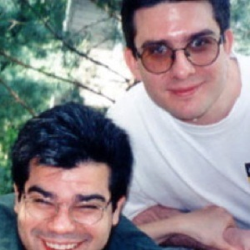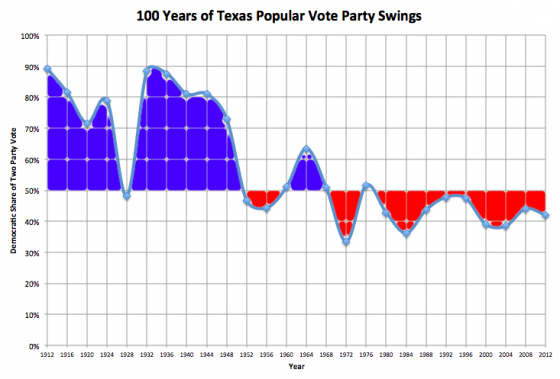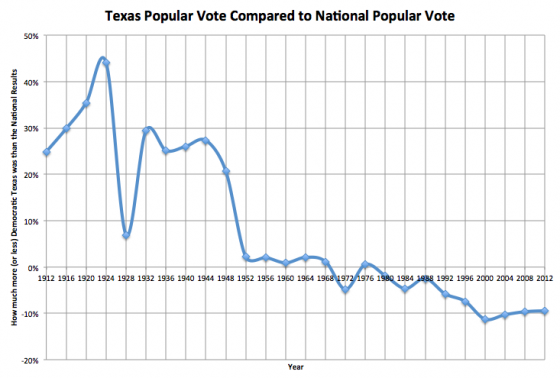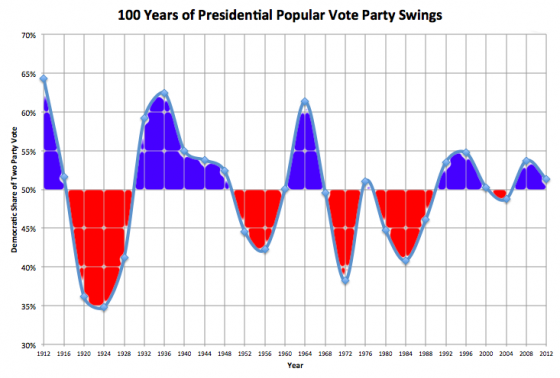|
Earlier this week, Andrew Sullivan had a series of posts exploring trends in Texas that may eventually make it a swing state. (Part 1, Part 2, Part 3) This prompted me to wonder what the actual numbers were and what the trend might look like. Demographic trends may well cause changes in the electoral balance in Texas at some point in the future, but looking at actual historical election results shows no such trend so far. Similar to the chart I did of national trends on Sunday, the chart above shows the Democratic proportion of the two party vote (ignoring third parties) over the last 100 years, this time just for Texas. Over this timescale, clearly the trend is from a very reliable Democratic state prior to 1950 to a solid Republican state since 1970. Looking just since 1970, one could argue that the trend is fairly flat, but if you look at how winning Democratic presidents have done, you see that Clinton did not match Carter’s numbers (Carter actually won Texas in 1976) and then Obama has not matched Clinton’s numbers. Each winning Democratic president has done worse in Texas than the one before. Now, one could say that Obama did better in Texas than Kerry or Gore, and that would be quite true. But it seems like that is more just a factor of being a winning candidate, and thus having higher levels of support overall. And in the most recent timeframe you can look at, Obama 2012 didn’t do as well as Obama 2008. There may be underlying demographic trends that will eventually favor Democrats in Texas, but they haven’t actually started to bend the curve there quite yet. But wait! There is another way of looking at this! I hinted at it when I mentioned that the winning Democratic candidates (Obama, Clinton, Carter) got a boost compared to the losing Democratic candidates (Kerry, Gore, Dukakis, Mondale) just by virtue of being winners. You can correct for this by looking at how Texas voted relative to the national vote rather than just looking at Texas in isolation. If you take the Democratic percentage of the two party vote in Texas, and subtract from that the Democratic percentage of the two party vote nationwide, you get a measure of how much more (or less) Democratic Texas is than the country at large. With this, you get the following chart: I’ve left out the red and blue coloring this time because it clutters up the image, but this chart is a lot less noisy. You still see a very clear trend with Texas becoming less Democratic and more Republican over the last 100 years (compared to the rest of the country). In this view however you CAN see an inflection point at the 2000 election. Up until 2000 Texas was clearly getting more Republican (compared to the rest of the country) with almost every election. Then that trend seems to stop. In 2000 Texas was 11.2% more Republican than the nation.* Each election since then the difference between Texas and the national average has been slightly less. In 2004 Texas was 10.3% more Republican. In 2008 it was 9.6%. And in 2012 the preliminary numbers have it at 9.4%. At that rate Texas still has a LONG time to go until it is really close to the national numbers. But with this view, you actually do see a trend with Texas’s Republican lean (relative to the rest of the country) decreasing slightly over the past few elections. * I’m being slightly sloppy with language here, to be more correct I would say that the Democratic proportion of the 2 party vote was 11.2% less in Texas than the Democratic proportion of the 2 party vote nationwide. Note: Data from uselectionatlas.org.
With all the talk of demographic trends favoring the democrats I thought I would just pull some really long term past data and see what the trends look like. The chart above is the Democratic percentage of the Republican/Democratic popular vote. That is, it leaves out third parties, even though they were significant in some of these years. And even though I generally prefer looking at the electoral college in Presidential elections, for this purpose popular vote seemed better. The one thing that immediately stands out to me is actually not a trend toward Democrats, but a “dampening” effect. The numbers were so much more volatile prior to 1976. I’ll skip the big 1912 to 1924 swing because 1912 was an oddball election… the Republicans actually came in third behind the Democrats and Progressives. But looking further on for examples, we went from Calvin Coolidge (R) blowing out John Davis (D) in 1924 by a 65.2% to 34.8% margin, to Franklin Roosevelt (D) crushing Alfred Landon (R) by a 62.5% to 37.5% margin only 12 years later. That is a LOT of people flipping from Republican to Democrat. Now, admittedly, there was a little thing called the Great Depression that probably caused that swing. But still, it is a HUGE number of people moving from one party to the other compared to what seems possible today. A slightly more recent big swing… In 1964 Johnson (D) beat Goldwater (R) 61.3% to 38.7%. Only 8 years later in 1972, Nixon (R) beat McGovern (D) 61.8% to 38.2%. Again, there was a major event, the Vietnam War, that could explain this, but this still represents a HUGE number of people switching parties. Not just demographic trends, but people actively switching their support. In addition to big swings, margins in general tended to be bigger. From 1912 to 1984, 13 of 19 elections… over 2/3 of the elections… were won by margins greater than 10%. The last time that happened was Reagan’s 1984 win over Mondale. We have now gone 7 elections in a row where the elections were one by less than a 10% margin. Of those 7 elections since Reagan, the margin was less than 3% three times. From Woodrow Wilson in 1912 to Ronald Reagan in 1984, there were also only three elections… out of 19 elections… with a margin under 3%. (That would be 1960, 1968 and 1976.) Elections this close used to be really rare. They aren’t the “norm” now, 1988, 1992, 1996, and 2008 were all won by more than 7%, but under 3% is certainly no longer rare. Now what about that trend toward the Democrats? Now, looking at the full 100 years, the oscillation between the parties and the reduction in volatility is the biggest thing you notice, but you could argue that the politics and issues and how the parties were aligned was dramatically different prior to the 1970s. So, if you look selectively just at 1972 onward, you do see a trend toward the Democrats. In the 70’s and 80’s you had big Republican wins and the only Democratic win was a squeaker. In the 90’s and 00’s you had smaller Democratic wins, with the only Republican wins being a popular vote loss in 2000 which was won in the electoral college, and a narrow win in 2004. If you change your starting point though, and look just since the 1990’s, the trend is (slightly) back toward the Republicans. Obama’s two wins were by smaller margins than Clinton’s wins. The demographic trends DO seem to be against the Republicans at the moment given how party preferences have been breaking down by ethnic group. But… The important thing to remember however is that parties change over time. The Republicans of 2012 are nothing like the Republicans of 1988. And the Republicans of 1988 didn’t look much like the Republicans of 1964. How much any demographic trends affect future presidential races will depend a lot on the internal dynamics of both parties, and who they nominate, and if the parties start shifting around as they do periodically. If the Republicans figure out how to embrace rather than alienate the non-white groups that are growing rapidly, then they will be able to blunt or reverse any demographic trends. Or we could have a major event like the Great Depression or the Vietnam war that returns us to the days of huge landslides for whichever party is NOT blamed for the bad event, with huge swings between the parties in short periods of times. We’ve been in a period of relatively close elections, with relatively little volatility between elections. That seems to be unusual looking back at the last 100 years. It could be the new “normal” that lasts another 50 years. But it just as easily could be an anomaly, and we’ll return to “normal” soon. As usual, past performance is not indicative of future results, but it is fun to look back at the longer term history for some context.
|
||






